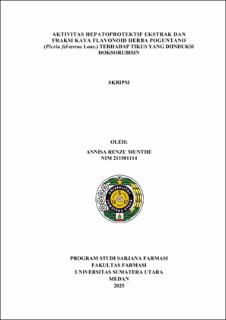Aktivitas Hepatoprotektif Ekstrak dan Fraksi Kaya Flavonoid Herba Poguntano (Picria fel-terrae Lour.) Terhadap Tikus yang Diinduksi Doksorubisin
Hepatoprotective Activity of Extracts and Flavonoid-Rich Fractions of Herba Poguntano (Picria fel-terrae Lour.) on Doxorubicin Induced Rates

Date
2025Author
Munthe, Annisa Renzu
Advisor(s)
Juwita, Nur Aira
Dalimunthe, Aminah
Metadata
Show full item recordAbstract
Background: Doxorubicin (DOX) is a potent and widely used chemotherapy for various cancers. However, it can cause toxicity when used chronically or in high doses. Poguntano (Picria fel-terrae Lour.) with high flavonoid content is known to have diuretic, antipyretic, hepatoprotective, cardioprotective, antidiabetic, antioxidant, anti-inflammatory, anthelmintic, and analgesic activities.
Objective: To determine the effect of flavonoid-rich extract or fraction of poguntano herb (Picria fel-terrae Lour.) as hepatoprotector in doxorubicin-induced male rats.
Methods: This study was conducted experimentally with research stages including the preparation of simplisia, making ethanol extract of poguntano herb with reflux method using 70% ethanol solvent, characterization of simplisia and extracts, phytochemical screening of simplisia and extracts, making fractions, testing the total flavonoid content of extracts and fractions, and testing on experimental animals. Rats were divided into 6 treatment groups, namely, positive quercetin 50 mg/kg BW, negative CMC-Na 0.5%, and the remaining fraction of poguntano herb in doses of 50, 100, 200, and 400 mg/kg BW. Mice were given oral treatment for 9 days. On days 8 and 9, doxorubicin 10 mg/kg BW was administered i.p. on day 10. On the 10th day, blood was taken from the heart of rats and centrifuged to obtain blood and serum for histology tests, and measurement of liver damage parameters namely SGOT, SGPT, ALP, and albumin.
Results: Based on the results obtained, the highest total flavonoid content was found in the residual fraction of Poguntano herb (FSHP), amounting to 65.011 mg QE/g. Based on liver histology observations, several types of damage were observed in the negative control group (0.5% Na CMC + DOX). Damage was also observed in the 50 mg/kg BW dose group. However, no severe damage was observed in the 200 mg/kg BW and 400 mg/kg BW dose groups. Based on the results of the liver damage parameters, it was found that the 400 mg/kg BW and 200 mg/kg BW doses did not affect the levels of ALT, AST, ALP, and albumin.
Conclusion: Then it can be concluded that the flavonoid-rich fraction of poguntano herb has activity as a hepatoprotector.
Collections
- Undergraduate Theses [1833]
